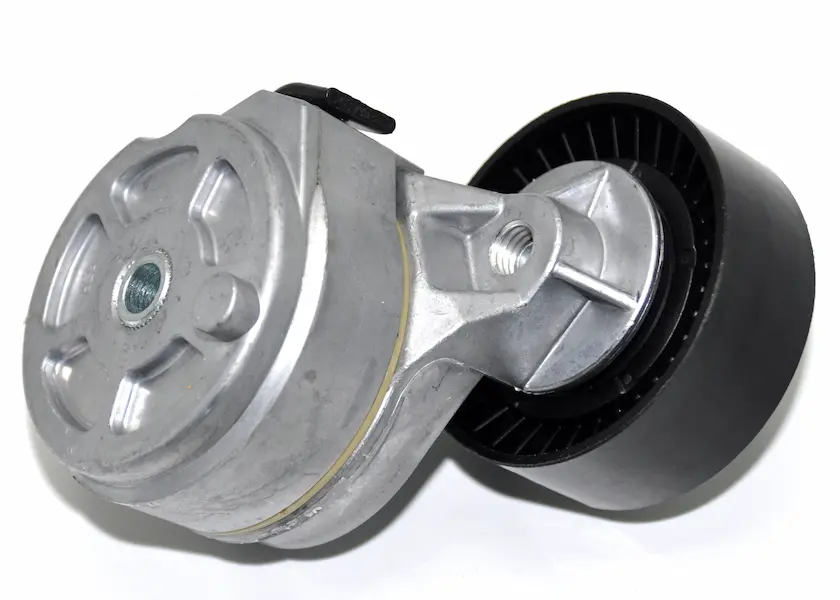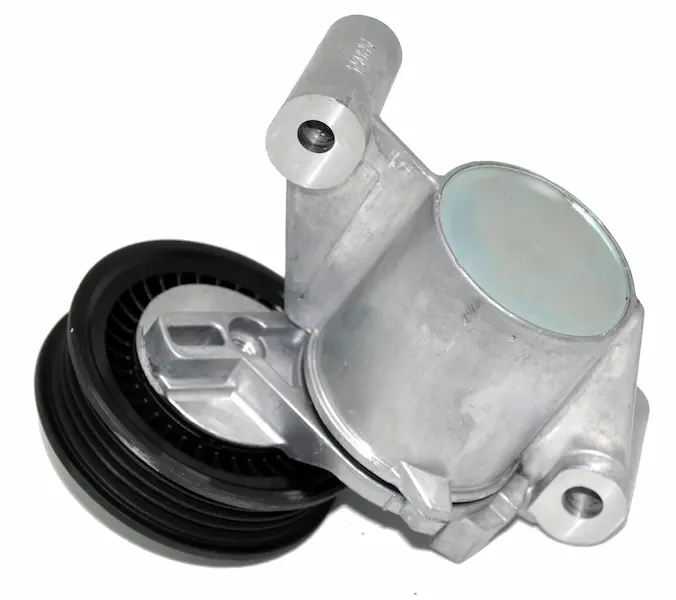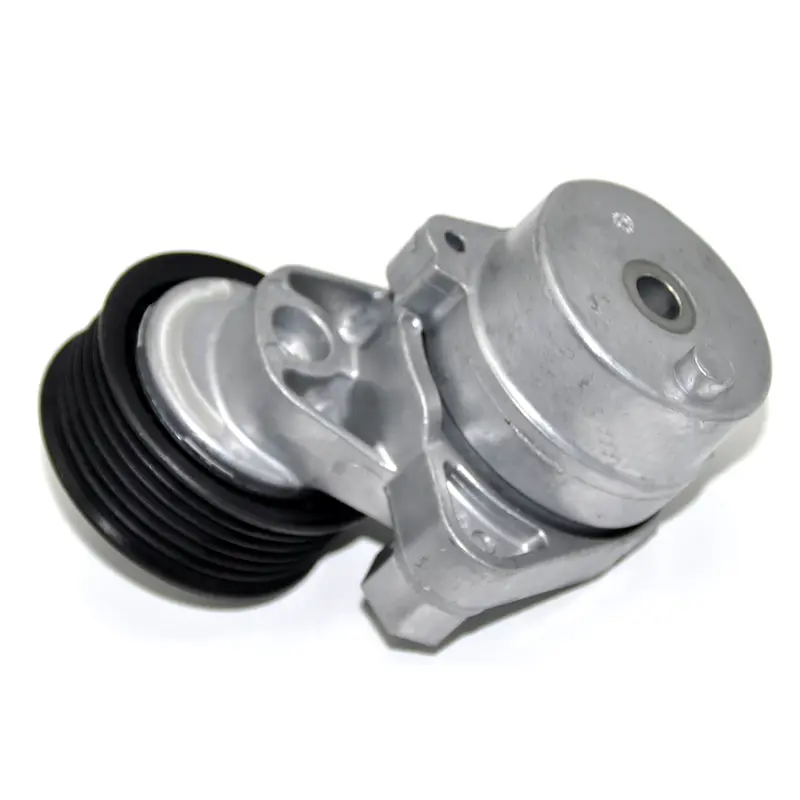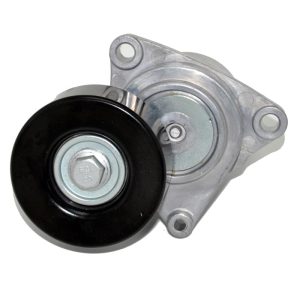Dalam bidang mesin otomotif dan industri, peran tensioner dan katrol pemalas sangat penting namun sering diabaikan. Komponen ini, meskipun berukuran kecil, memainkan peran penting dalam fungsionalitas dan umur panjang berbagai sistem, terutama dalam mekanisme yang digerakkan oleh sabuk. Memahami apa bagian katrol penegang dan pemalas adalah, bagaimana fungsinya, dan pentingnya komponen ini sangat penting bagi siapa pun yang terlibat dalam pemeliharaan, perbaikan, atau desain sistem mekanis. Artikel ini membahas secara spesifik komponen-komponen ini, mengeksplorasi jenis, fungsi, dan dampaknya terhadap kinerja sistem secara keseluruhan.
Dasar-dasarnya: Memahami Komponen Katrol Tensioner dan Idler
Sebelum membahas secara spesifik, penting untuk memahami konsep dasar tensioner dan katrol pemalas. Kedua komponen tersebut merupakan bagian integral dari berfungsinya sistem yang digerakkan oleh sabuk, yang umum digunakan pada mesin otomotif dan berbagai mesin industri.
- Katrol Penegang: Katrol tensioner adalah komponen yang dirancang untuk mempertahankan tegangan yang tepat pada sabuk dalam sistem yang digerakkan oleh sabuk. Biasanya katrol ini bermuatan pegas atau dioperasikan secara hidraulik, sehingga dapat menyesuaikan secara otomatis untuk mengimbangi keausan dan pemanjangan belt seiring waktu. Dengan mempertahankan tegangan yang tepat, katrol tensioner memastikan bahwa belt beroperasi dengan lancar dan efisien, mencegah selip, kebisingan, dan keausan dini.
- Katrol Pemalas: Katrol pemalas, di sisi lain, memiliki tujuan yang berbeda. Katrol ini digunakan untuk memandu atau mengarahkan sabuk ke arah tertentu. Meskipun tidak berkontribusi dalam menjaga ketegangan, katrol idler memastikan bahwa sabuk mengikuti jalur yang benar di sekitar berbagai komponen mesin, seperti alternator, pompa air, atau pompa power steering. Katrol idler biasanya dipasang pada posisinya dan tidak dapat menyesuaikan ketegangan.
Pentingnya Suku Cadang Tensioner dan Katrol Idler
Baik komponen tensioner maupun katrol pemalas sangat penting untuk pengoperasian sistem yang digerakkan oleh sabuk yang efisien. Kerusakan atau kegagalan pada salah satu komponen ini dapat menyebabkan masalah yang signifikan, termasuk hilangnya daya, mesin terlalu panas, atau bahkan kegagalan sistem secara keseluruhan.
- Memastikan Ketegangan Sabuk yang Tepat: Peran utama katrol tensioner adalah untuk mempertahankan jumlah tegangan yang benar pada sabuk. Sabuk yang longgar dapat tergelincir, menyebabkan hilangnya daya pada komponen yang digerakkan, sementara sabuk yang terlalu kencang dapat menyebabkan keausan yang berlebihan pada sabuk dan katrol itu sendiri. Katrol tensioner secara otomatis menyesuaikan untuk menjaga ketegangan sabuk dalam kisaran optimal, memastikan pengoperasian yang lancar dan memperpanjang umur sabuk.
- Memandu Sabuk: Peran katrol pemalas dalam memandu sabuk sama pentingnya. Dengan mengarahkan belt di sepanjang jalur yang benar, katrol idler memastikan bahwa belt menggerakkan setiap komponen dalam sistem dengan benar. Katrol pemalas yang tidak sejajar atau rusak dapat menyebabkan sabuk menyimpang dari jalur yang dimaksudkan, yang menyebabkan keausan yang tidak merata, kebisingan, atau bahkan kegagalan total sabuk.
- Mengurangi Keausan dan Kerusakan: Baik katrol tensioner maupun idler memainkan peran penting dalam mengurangi keausan pada belt dan komponen lainnya. Dengan mempertahankan tegangan yang tepat dan memandu belt dengan benar, katrol ini membantu mendistribusikan beban secara merata ke seluruh belt, mengurangi stres dan memperpanjang usia seluruh sistem.
- Mencegah Kegagalan Sistem: Kegagalan pada bagian tensioner dan katrol idler dapat berakibat serius. Katrol yang patah atau rusak dapat menyebabkan sabuk tergelincir atau putus, yang menyebabkan hilangnya daya ke komponen penting seperti alternator atau pompa air. Pada mesin otomotif, hal ini dapat menyebabkan kegagalan baterai, panas berlebih, atau bahkan kerusakan mesin. Pada mesin industri, katrol yang rusak dapat menyebabkan waktu henti dan perbaikan yang mahal.
Jenis-jenis Suku Cadang Katrol Tensioner dan Idler
Ada berbagai jenis komponen katrol penegang dan pemalas, masing-masing dirancang untuk memenuhi persyaratan khusus tergantung pada aplikasinya. Memahami perbedaan antara jenis-jenis ini sangat penting untuk memilih katrol yang tepat untuk sistem tertentu.
- Penegang Manual: Tensioner manual memerlukan penyesuaian berkala untuk mempertahankan ketegangan sabuk yang benar. Tensioner ini biasanya digunakan pada kendaraan tua dan mesin industri di mana sistem otomatis tidak memungkinkan. Keuntungan utama dari tensioner manual adalah kesederhanaan dan keefektifan biayanya, tetapi membutuhkan perawatan rutin untuk memastikan pengoperasian yang benar.
- Penegang Otomatis: Tensioner otomatis adalah jenis yang paling umum digunakan pada kendaraan dan mesin modern. Tensioner ini menggunakan mekanisme pegas untuk mempertahankan tegangan yang konstan pada sabuk, secara otomatis menyesuaikan keausan dan pemanjangan sabuk. Tensioner otomatis lebih nyaman daripada tensioner manual, karena hanya membutuhkan sedikit atau bahkan tanpa perawatan. Namun, harganya bisa lebih mahal dan mungkin memerlukan instalasi yang lebih rumit.
- Tensioner Hidraulik: Tensioner hidraulik adalah jenis tensioner otomatis yang menggunakan tekanan hidraulik untuk mempertahankan ketegangan sabuk. Tensioner ini sering digunakan dalam aplikasi berkinerja tinggi atau tugas berat yang membutuhkan kontrol tegangan yang tepat. Tensioner hidraulik menawarkan keuntungan pengoperasian yang lebih mulus dan peredaman getaran belt yang lebih baik, tetapi juga lebih kompleks dan mahal daripada jenis tensioner lainnya.
- Katrol Idler Tetap: Katrol pemalas tetap adalah jenis katrol pemalas yang paling umum, biasanya digunakan untuk memandu sabuk ke arah tertentu. Katrol ini dipasang pada braket tetap dan tidak bergerak atau menyesuaikan. Katrol pemalas tetap sederhana dan andal, membuatnya cocok untuk sebagian besar aplikasi.
- Katrol Pemalas yang Dapat Disetel: Katrol pemalas yang dapat disetel memungkinkan beberapa tingkat penyesuaian pada jalur sabuk. Bagian-bagian tensioner dan katrol idler ini dipasang pada braket yang dapat disetel untuk mengubah posisi katrol, sehingga memungkinkan koreksi kecil pada keselarasan sabuk. Katrol idler yang dapat disetel berguna dalam aplikasi di mana penyelarasan sabuk yang tepat diperlukan, tetapi memerlukan pemasangan dan penyesuaian yang cermat.
Masalah Umum dan Kiat Perawatan
Seperti komponen mekanis lainnya, komponen tensioner dan katrol pemalas dapat aus seiring waktu atau mengalami masalah yang memerlukan perhatian. Perawatan dan pemeriksaan rutin sangat penting untuk memastikan umur panjang dan keandalan komponen-komponen ini.
- Keausan dan Kerusakan: Seiring waktu, bantalan pada puli tensioner dan idler dapat aus, yang menyebabkan peningkatan gesekan, kebisingan, dan akhirnya kegagalan. Memeriksa katrol secara teratur untuk mengetahui tanda-tanda keausan, seperti goyangan, derit, atau suara gerinda, dapat membantu mendeteksi masalah secara dini sebelum menyebabkan masalah yang lebih serius.
- Ketidaksejajaran Sabuk: Ketidaksejajaran sabuk adalah masalah umum yang dapat menyebabkan keausan dini pada sabuk dan katrol. Ketidaksejajaran dapat disebabkan oleh katrol pemalas yang rusak atau aus, braket yang bengkok, atau pemasangan yang tidak tepat. Memastikan bahwa semua katrol disejajarkan dengan benar sangat penting untuk kelancaran sistem.
- Kegagalan Tensioner: Tensioner yang gagal dapat menyebabkan sabuk longgar atau terlalu kencang, yang menyebabkan selip, suara berisik, dan keausan yang berlebihan. Tanda-tanda kegagalan tensioner termasuk suara yang tidak biasa, gerakan sabuk yang berlebihan, atau kerusakan yang terlihat pada mekanisme tensioner. Mengganti tensioner yang rusak dengan segera sangat penting untuk mencegah kerusakan lebih lanjut pada sistem.
- Penggantian Reguler: Komponen katrol penegang dan idler, seperti komponen lain yang aus, harus diganti secara berkala untuk mencegah kerusakan yang tidak terduga. Mengikuti jadwal penggantian yang direkomendasikan pabrikan dan menggunakan suku cadang pengganti berkualitas tinggi dapat membantu memastikan masa pakai sistem yang lama.
Kesimpulan
Komponen katrol penegang dan pemalas mungkin merupakan komponen kecil, tetapi perannya dalam pengoperasian sistem yang digerakkan oleh sabuk yang efisien tidak dapat dilebih-lebihkan. Dengan mempertahankan tegangan sabuk yang tepat dan memandu sabuk di sepanjang jalur yang benar, katrol ini membantu memastikan pengoperasian yang mulus dan andal dari berbagai sistem mekanis. Memahami berbagai jenis katrol penegang dan pemalas, fungsinya, dan masalah umum yang dapat mereka kembangkan sangat penting bagi siapa pun yang terlibat dalam pemeliharaan atau desain sistem ini. Pemeriksaan rutin, perawatan, dan penggantian komponen ini secara tepat waktu adalah kunci untuk mencegah kegagalan yang merugikan dan memastikan umur panjang seluruh sistem.




